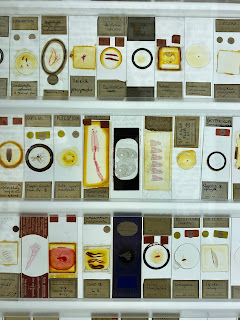Reviews of Curiosity and Zoology Museums: Viktor Wynd, House of Dreams, Grant Museum of Zoology
To reflect on World Wildlife Day on March 3rd in the museum sector, we take a look at the role of curiosity museums and highlight visits and reflections on these unusual places and their even more unusual collections: The Viktor Wynd Museum, House of Dreams, and the Grant Museum of Zoology.
Curiosity museums are historically associated with Cabinets of Curiosities: private collections that were usually built up by members of the aristocracy, particularly in the 17th century. Individuals who owned the collections were also usually the curators, controlling how party guests or visitors interpreted the objects. These objects included a wide range of things: taxidermy, preserved wildlife, literature, objects of scientific interest, collected from their travels or (secretly) from local markets.
The representation of wildlife and nature was somewhat irrational, containing a strong element of storytelling and personal narrative. Items such as the magician's 'moles in a jar', or 'mermaids' that were a taxidermy of different animals sewn together, were artworks and oddities that linked the natural world to mythologies and magic. Curiosity cabinets and museums created a world of their own that re-framed the relationship between human imagination and nature's unknown.
They take objects of nature and, unlike natural history museums that began to classify natural objects, create a surrealist space that stages our relationships with nature; it is adopted into spiritual practices, performances, and the preservation of memory.
Below are 3 number of museums I reflect on and the role of the collections' owner and their influence over the narrative.
Viktor Wynd Museum of Curiosities, Hackney, London
The Viktor Wynd Museum, reportedly once visited by David Bowie, is run by Wynd himself and features a vast collection of oddities from travels, auctions, and gifts. The space includes a giant lion's skeleton, anthropomorphic magician's objects such as shrunken heads and a 'mermaid'. There is no chronological or categorical organisation to the exhibits. But there is play, whether it is satire, juxtaposition, between objects and words, signs, and vintage books with obscene titles that are out of print. Personality is expressed as the tale the owner wants to tell about these objects and what they mean to them.
Many objects are just strewn about. Curiosity cabinets are dense and full to the brim, meant to immerse and overwhelm with a sense of mystery and adventure. Despite being a small space, you could easily spend 1-2 hours discovering objects in the dimly-lit space. Some objects would be unrecognisable if it weren't for hand-written labels hanging off them like old luggage tags.
This dim lighting is also associated with the Renaissance aristocratic parties in which owners would entertain guests in the evening with these objects of curiosity alongside extravagant tales (true or not) [1].
House of Dreams, Dulwich, London
This museum tells a more intimate story inside the home of artist Stephen Wright. It is the work of 10+ years and a celebration of craftsmanship. The site is a handmade construction including mosaic, calligraphy, poetry, old letters, and artworks. It tells a story of personal histories, memory, relationships and loss. It also takes inspiration from the 18th century 'shell grottos' which were typically underground crafted spaces inspired by caves and Rococo styles [2]. The journey begins in the vibrant mosaic front garden, goes through the indoor labyrinth, and ends in a darker, more serene, jungle-like back garden.
Wright's home museum has bohemian vibrant colours and a consumerist irony. Some items were purchased, some found in skips, alongside deeply personal letters and poetry that continues through the space like a monologue. The contrasts again are what create a bold narrative in these curiosity museums, compared to the order and boundaries found in most museums. As with the Viktor Wynd museum, the owners/curators are there to speak with. Wright, who led us around the space, said he has continued to add to it over the years as a work in progress and it has become a personal legacy.
The idea of time: life and decay, is interestingly shown here through items such as plastic dolls which have been burnt or dismembered, smashed ceramics, and memorials of loved ones. This contemporary museum had a lot more plastic, and as it does not decompose the same way naturally, Wright burned/damaged the plastic to suggest [a permanent state of] decay. Another irony compared to the preservation methods in natural history collections.
You are left with a strong sense of nostalgia and sadness, despite the kitschy pop art aesthetic. It felt like being on a trip inside someone else's mind.
Grant Museum of Zoology, UCL
I was lucky enough to attend a workshop that explored individual objects inside the museum, such as a section of an elephant tusk with a bullet still embedded in it and a rabbit's face which over time has morphed into a grotesque mask quite unlike a rabbit. Our group responded to these objects by starting discussions around memory, time, and death.
We looked at two main ways that natural objects are preserved in museums: dry, such as taxidermy and bones, or wet, such as items preserved in formaldehyde. Animals in this state change shape and form over time and look more unnatural. This raises the idea that we can never preserve time only attempt it and things cannot be remembered exactly as they were. We see clearly the attempt to stop nature in its tracks, to study it, classify it; morphing out of shape. Natural decay, in this light, seems more forgiving.
I found it really interesting to compare these 3 museums, the different materials found in them such as plastic, wood, dust, faint chemicals, and the different smells each one carried. They make you think about time and what a museum tries to 'stop in its tracks' for you to experience.
[2] https://londongardenstrust.org/features/grotto.htm
Alia
Marketing Assistant














Comments
Post a Comment